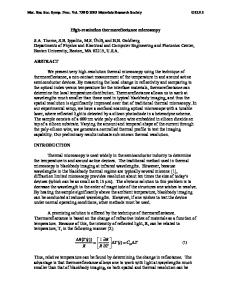High Resolution Microscopy of Pd/InP Interfaces
- PDF / 2,649,460 Bytes
- 6 Pages / 414.72 x 648 pts Page_size
- 70 Downloads / 386 Views
J.W. PALMER AND W.A. ANDERSON State University of New York at Buffalo, Department of Electrical and Computer Engineering, Center for Electronic and Electro-Optic Materials, 215 Bonner Hall, Buffalo, NY 14260 D.T. HOELZER Alfred University, NYS College of Ceramics, McMahon Hall, Alfred, NY 14802
ABSTRACT Depositing Pd on InP at cryogenic substrate temperatures has previously been found to significantly increase the barrier height of the resulting Schottky diode. In this work, bulk samples of Pd/n-InP were fabricated using substrate temperatures of 300K (RT) and 77K (LT). The structural differences between the RT and LT samples were then studied using CrossSectional Transmission Electron Microscopy (XTEM), Atomic Force Microscopy (AFM), XRay Diffraction (XRD), Auger Electron Spectroscopy (AES), and Secondary Ion Mass Spectroscopy (SIMS). The XTEM and depth profiling results indicated that the RT samples had an amorphous interaction layer approximately 150A thick, while the LT samples had an interfacial layer less than 30A thick. Therefore, depositing Pd at low temperatures greatly reduced the interaction between Pd and InP. XRD lines corresponding to (111) and (200) Pd were obtained as well. The lines in the RT case had a greater integrated intensity than in the LT case, indicating that the RT Pd had a higher degree of crystallinity. AFM was used to compare the morphology of the LT and RT Pd surfaces as a function of metal thickness. INTRODUCTION InP is an attractive III-V compound semiconductor for use in high-speed field-effect transistors and optical devices. However, conventional Schottky barriers formed on n-InP typically exhibit low barrier heights in the range of 0.4-0.55 eV, hindering the development of these devices. Recently, it was found that depositing Pd on n-InP at liquid nitrogen substrate temperatures resulted in a very high barrier height of 0.96 eV [1-3], although the reason this occurred was not well understood. In this work, techniques such as XTEM and AFM were used to compare the structural differences between Pd/InP samples formed at room temperature and low temperature. The differences found aid our understanding of why the LT deposition results in a greatly improved barrier height. EXPERIMENT Bulk samples of Pd/n-InP were formed at room temperature and liquid nitrogen temperature. The InP was first cleaned in acetone, methanol, and de-ionized H 20. It was then etched in H 2SO 4 :H2 0 2 :H2 0 (3:1:1) for 1 min, HF/H 2 0 (1:1) for 1 min, rinsed, and dried with N2 gas. Pd deposition was done by thermal evaporation at a base pressure in the 10-8 Torr range. In the LT case, the substrate was cooled to near 77K with liquid nitrogen prior to deposition. 477 Mat. Res. Soc. Symp. Proc. Vol. 355 @1995 Materials Research Society
Thin-foils for XTEM were then fabricated using a standard procedure of stack construction, slicing, thinning, disc cutting, dimpling and ion milling [4]. The microscopy was done using a JEOL 2000FX operating with a 200keV accelerating potential. XRD was performed on bulk sampl
Data Loading...









